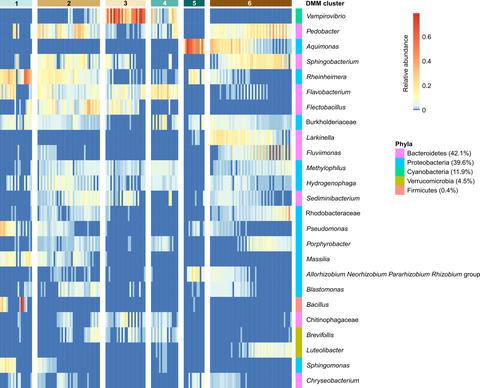当前位置:
X-MOL 学术
›
Microb. Biotechnol.
›
论文详情
Our official English website, www.x-mol.net, welcomes your
feedback! (Note: you will need to create a separate account there.)
Association between algal productivity and phycosphere composition in an outdoor Chlorella sorokiniana reactor based on multiple longitudinal analyses.
Microbial Biotechnology ( IF 4.8 ) Pub Date : 2020-05-25 , DOI: 10.1111/1751-7915.13591 Seth A Steichen 1 , Song Gao 2 , Peter Waller 3 , Judith K Brown 1
Microbial Biotechnology ( IF 4.8 ) Pub Date : 2020-05-25 , DOI: 10.1111/1751-7915.13591 Seth A Steichen 1 , Song Gao 2 , Peter Waller 3 , Judith K Brown 1
Affiliation

|
Microalgae as a biofuel source are of great interest. Bacterial phycosphere inhabitants of algal cultures are hypothesized to contribute to productivity. In this study, the bacterial composition of the Chlorella sorokiniana phycosphere was determined over several production cycles in different growing seasons by 16S rRNA gene sequencing and identification. The diversity of the phycosphere increased with time during each individual reactor run, based on Faith’s phylogenetic diversity metric versus days post‐inoculation (R = 0.66, P < 0.001). During summer months, Vampirovibrio chlorellavorus, an obligate predatory bacterium, was prevalent. Bacterial sequences assigned to the Rhizobiales, Betaproteobacteriales and Chitinophagales were positively associated with algal biomass productivity. Applications of the general biocide, benzalkonium chloride, to a subset of experiments intended to abate V. chlorellavorus appeared to temporarily suppress phycosphere bacterial growth, however, there was no relationship between those bacterial taxa suppressed by benzalkonium chloride and their association with algal productivity, based on multinomial model correlations. Algal health was approximated using a model‐based metric, or the ‘Health Index’ that indicated a robust, positive relationship between C. sorokiniana fitness and presence of members belonging to the Burholderiaceae and Allorhizobium–Neorhizobium–Pararhizobium–Rhizobium clade. Bacterial community composition was linked to the efficiency of microalgal biomass production and algal health.
中文翻译:

基于多重纵向分析的室外 Chlorella sorokiniana 反应器中藻类生产力和藻圈组成之间的关联。
微藻作为生物燃料来源引起了人们的极大兴趣。假设藻类培养物中的细菌藻圈居民有助于生产力。在这项研究中,通过 16S rRNA 基因测序和鉴定,确定了不同生长季节的几个生产周期中Chlorella sorokiniana藻圈的细菌组成。根据 Faith 的系统发育多样性指标与接种后天数的关系,藻圈的多样性在每个反应器运行期间随着时间的推移而增加( R = 0.66, P < 0.001)。在夏季,吸血弧菌(一种专性捕食性细菌)十分普遍。分配给根瘤菌目、β-变形菌目和几丁菌目的细菌序列与藻类生物量生产力呈正相关。将通用杀菌剂苯扎氯铵应用于旨在消除绿藻弧菌的一组实验中似乎暂时抑制了藻圈细菌的生长,但是,苯扎氯铵抑制的那些细菌分类群与其与藻类生产力的关联之间没有关系。多项式模型相关性。使用基于模型的指标或“健康指数”对藻类健康状况进行了近似,该指数表明C. sorokiniana 的适应性与属于 Burholderiaceae 和 Allorhizobium-Neorhizobium-Pararhizobium-Rhizobium clade 成员的存在之间存在强大的正相关关系。细菌群落组成与微藻生物量生产的效率和藻类健康有关。
更新日期:2020-05-25
中文翻译:

基于多重纵向分析的室外 Chlorella sorokiniana 反应器中藻类生产力和藻圈组成之间的关联。
微藻作为生物燃料来源引起了人们的极大兴趣。假设藻类培养物中的细菌藻圈居民有助于生产力。在这项研究中,通过 16S rRNA 基因测序和鉴定,确定了不同生长季节的几个生产周期中Chlorella sorokiniana藻圈的细菌组成。根据 Faith 的系统发育多样性指标与接种后天数的关系,藻圈的多样性在每个反应器运行期间随着时间的推移而增加( R = 0.66, P < 0.001)。在夏季,吸血弧菌(一种专性捕食性细菌)十分普遍。分配给根瘤菌目、β-变形菌目和几丁菌目的细菌序列与藻类生物量生产力呈正相关。将通用杀菌剂苯扎氯铵应用于旨在消除绿藻弧菌的一组实验中似乎暂时抑制了藻圈细菌的生长,但是,苯扎氯铵抑制的那些细菌分类群与其与藻类生产力的关联之间没有关系。多项式模型相关性。使用基于模型的指标或“健康指数”对藻类健康状况进行了近似,该指数表明C. sorokiniana 的适应性与属于 Burholderiaceae 和 Allorhizobium-Neorhizobium-Pararhizobium-Rhizobium clade 成员的存在之间存在强大的正相关关系。细菌群落组成与微藻生物量生产的效率和藻类健康有关。











































 京公网安备 11010802027423号
京公网安备 11010802027423号